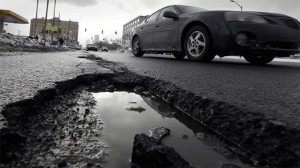The typical American motorist will spend $300 this year repairing vehicle damage caused by potholes, according to a new report by the AAA, and as the American highway infrastructure continues to worsen, the problem could continue to get worse.
The problem will become even more apparent in the weeks ahead, as roadways begin to crumble as snow and ice begin to thaw. But despite the passage late last year of a new national transportation bill, the AAA study warns that another $170 billion in annual funding would be needed to catch up on the repairs needed for America’s roads and bridges.
“In the last five years, 16 million drivers across the country have suffered pothole damage to their vehicles,” said John Nielsen, AAA’s managing director of Automotive Engineering and Repair. “The problems range from tire punctures and bent wheels, to more expensive suspension damage.”
The typical vehicle, the survey found, experienced pothole damage three times during the last five years, with average annual repairs coming to $300, according to Nielsen. Nationwide, that adds up to a repair bill of around $15 billion a year.
And the figure might not fully reflect the real price tag. A blowout caused by a pothole can lead to a crash, and as motorists swerve to avoid potholes they also can cause an accident.
According to AAA, the vast majority of American motorists said they were worried about potholes and deteriorating roads. The travel and road safety firm’s survey found the greatest concern among those with households having annual incomes of less than $75,000 a year, those whose budgets are most strained by unexpected vehicle repairs.
The problem has led automakers to search for solutions. Ford, for example, will introduce new pothole protection technology onto its 2017 Fusion sedan. The system is able to detect when the vehicle is about to hit a pothole and automatically adjusts the shock absorbers so a wheel won’t drop into the crater.
(For more on the Fusion pothole protection system, Click Here.)
The tire industry, meanwhile, has expanded the availability of so-called Run Flat tires that won’t immediately go flat, even if they suffer damage from a pothole or road debris. That is meant to allow a motorist to keep driving for up to 50 miles, generally enough range to reach a repair shop or some other safe point.
The downside is that in the effort to reduce vehicle weight – and cut costs – a growing number of car manufacturers have stopped equipping vehicles with conventional spare tires. Mini spares are also going away, many vehicles now equipped with emergency inflator systems, instead. But they won’t work when a tire has experienced a major structural failure.
(Flatlining: what happened to the spare tire? Click Here to find out.)
To help motorists deal with bad roads, AAA recommends several steps that can prevent, or at least minimize, pothole damage.
It suggests drivers should “ensure tires are properly inflated and have adequate tread depth, as they are the only cushion between a pothole and the vehicle. If a pothole strike is inevitable, it is also critical that drivers slow down, release the brakes and straighten steering before making contact with the pothole. To avoid potholes in the roadway, drivers should remain alert, scan the road and increase following distances behind the vehicle ahead.”
(Car thefts suddenly on the rise again. Click Here to see why.)


